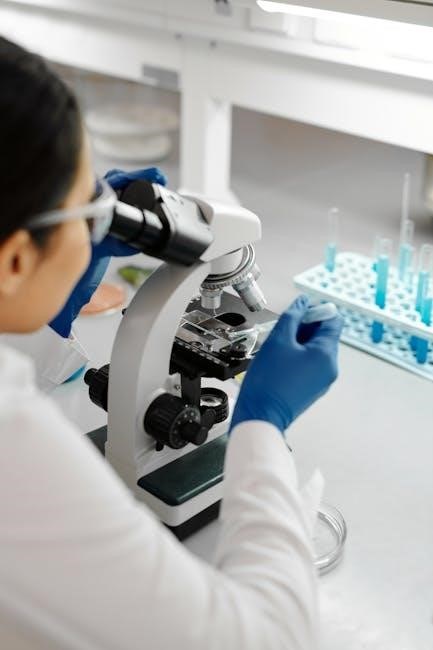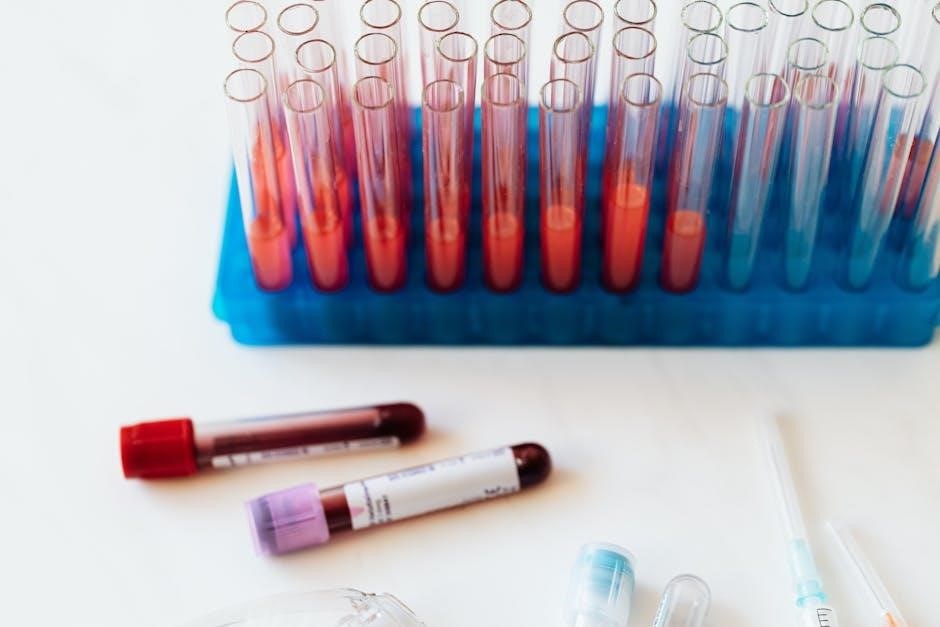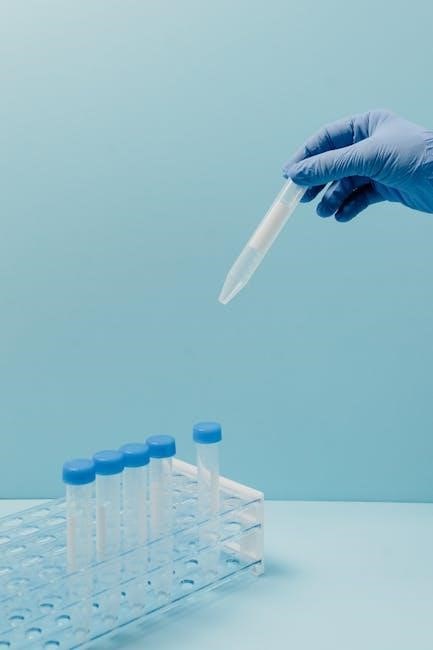Diagnostic and laboratory tests are essential tools in healthcare, providing critical information for assessing organ function, detecting diseases, and guiding treatment decisions.
They enable healthcare providers to monitor health conditions, confirm diagnoses, and evaluate treatment effectiveness, ensuring accurate and timely patient care.
Overview of Diagnostic and Laboratory Tests
Diagnostic and laboratory tests are medical procedures designed to assess an individual’s health status by analyzing biological samples or physiological data.
These tests provide healthcare professionals with essential information to diagnose diseases, monitor treatment efficacy, and detect potential health risks.
They encompass a wide range of examinations, including blood tests, imaging studies, and microbiological analyses, each serving distinct purposes.
Laboratory tests are conducted in controlled environments to ensure accuracy and reliability, while point-of-care tests offer rapid results in clinical settings.
By integrating advanced technologies and evidence-based practices, diagnostic testing plays a pivotal role in modern healthcare, enabling timely and informed decision-making.
Importance of Diagnostic Testing in Healthcare
Diagnostic testing is a cornerstone of healthcare, enabling accurate diagnoses, guiding treatment plans, and improving patient outcomes.
By identifying diseases early, these tests help prevent complications and reduce mortality rates.
They also monitor chronic conditions, ensuring treatments remain effective and safe.
Moreover, diagnostic tests inform clinical decisions, minimize unnecessary procedures, and optimize resource use.
Their role in detecting infections and tracking public health trends is vital.
Overall, diagnostic testing enhances the quality of care, supports personalized medicine, and empowers healthcare providers to deliver evidence-based interventions.

Types of Diagnostic Tests
Diagnostic tests include blood tests, imaging studies, clinical chemistry panels, and microbiology assessments. Each serves unique purposes, from assessing organ function to detecting infections and abnormalities.
Blood Tests
Blood tests are fundamental diagnostic tools used to assess overall health, detect diseases, and monitor treatment effectiveness. They measure various components, such as blood cell counts, chemical levels, and clotting factors. Common tests include complete blood counts (CBC), blood chemistry panels, and clotting studies. These tests help identify conditions like anemia, infection, diabetes, and liver or kidney dysfunction. Blood tests are also crucial for diagnosing cancers and metabolic disorders. Proper specimen collection and handling are essential to ensure accurate results, making them a cornerstone in preventive and therapeutic healthcare strategies.
Imaging Tests (X-rays, MRIs, CT Scans)
Imaging tests are non-invasive diagnostic tools that produce visual representations of internal body structures. X-rays use radiation to detect bone fractures, lung conditions, and foreign objects. MRIs (Magnetic Resonance Imaging) utilize magnetic fields and radio waves to provide detailed images of soft tissues, organs, and joints, aiding in diagnoses of injuries, tumors, and neurological disorders. CT (Computed Tomography) scans combine X-rays and computers to create cross-sectional images, often used for internal injuries, cancers, and vascular diseases. These tests are essential for diagnosing and monitoring conditions, offering valuable insights into anatomical abnormalities and disease progression, thereby guiding treatment plans effectively.
Clinical Chemistry Tests
Clinical chemistry tests analyze bodily fluids to assess health and diagnose diseases. These tests measure substances like glucose, cholesterol, and enzymes, providing insights into organ function.
They help detect conditions such as diabetes, liver disease, and kidney dysfunction. Common tests include blood glucose monitoring, lipid profiles, and electrolyte panels. These analyses are critical for early detection, disease management, and monitoring treatment efficacy. By evaluating metabolic activity and chemical balances, clinical chemistry tests play a vital role in preventive care and personalized medicine, ensuring accurate diagnoses and tailored therapeutic interventions for patients.
Hematology Tests
Hematology tests analyze blood components to assess overall health and diagnose conditions like anemia, bleeding disorders, and infections.
These tests measure red and white blood cell counts, hemoglobin levels, and platelet function, providing insights into oxygen transport, immune response, and clotting ability. Common tests include complete blood counts (CBCs) and blood smear examinations. Hematology tests are crucial for identifying blood-related disorders, such as leukemia, and monitoring chronic conditions like sickle cell anemia. By evaluating blood cell morphology and function, these tests aid in early detection, treatment planning, and disease management, playing a key role in maintaining patient health and well-being through accurate diagnostics.
Microbiology Tests
Microbiology tests identify pathogens such as bacteria, viruses, and fungi, aiding in the diagnosis of infections.
These tests involve culturing samples, PCR, or antibody detection to determine the presence and type of microorganisms. Common microbiology tests include urine cultures, stool tests, and blood cultures, which help diagnose conditions like sepsis or tuberculosis. They are crucial for guiding antibiotic therapy, ensuring effective treatment, and preventing resistance. Accurate results from microbiology tests enable healthcare providers to implement targeted therapies, reducing complications and improving patient outcomes. These tests are vital for managing infectious diseases and maintaining public health by identifying pathogens promptly and accurately.
Special Considerations in Diagnostic Testing
Special considerations in diagnostic testing include ensuring accuracy, addressing patient-specific factors, and integrating technology for efficient results.
These factors enhance the reliability and applicability of diagnostic outcomes.
Point-of-Care Testing (POCT)
Point-of-care testing (POCT) refers to medical testing performed at or near the site of patient care, enabling rapid diagnosis and treatment decisions.
POCT devices, such as handheld analyzers or smartphone-integrated tools, provide immediate results for conditions like infections or glucose levels.
This approach minimizes delays, improves patient outcomes, and reduces the need for repeat visits.
POCT is particularly valuable in emergency settings, remote areas, and during infectious disease outbreaks, where timely identification is critical.
Its integration with electronic health records (EHRs) ensures seamless data sharing and continuity of care.
POCT enhances patient monitoring and supports timely interventions, making it a vital component of modern healthcare.
Pediatric and Geriatric Testing
Pediatric and geriatric testing requires specialized considerations due to age-related physiological differences.
For children, tests are adapted to their smaller body sizes and developmental stages, ensuring accurate and safe assessments.
Geriatric testing focuses on managing chronic conditions and monitoring age-related changes in organ function.
Both populations may require adjusted reference ranges and tailored specimen collection methods.
These adaptations ensure accurate diagnoses and appropriate treatment plans, addressing the unique healthcare needs of these vulnerable groups.

Interpreting Test Results
Accurate interpretation of test results is crucial for diagnosis and treatment.
Understanding reference ranges and clinical context helps avoid errors, ensuring reliable healthcare decisions.
Understanding Reference Ranges
Reference ranges are standardized values used to interpret laboratory test results. They define the normal or expected range for a specific test in a healthy population.
These ranges vary by age, sex, and laboratory methods, ensuring accurate comparisons. Healthcare providers use reference ranges to determine if results are abnormal, aiding in diagnosis and treatment decisions.
Understanding these ranges is vital for interpreting test outcomes correctly, as variations may indicate underlying conditions or require further evaluation. Accurate interpretation ensures reliable and personalized patient care.
Common Pitfalls in Test Interpretation
Interpreting diagnostic tests requires careful consideration to avoid errors. Common pitfalls include misinterpreting reference ranges, ignoring pre-analytical factors, and overreliance on single test results.
Biological variability, sample collection errors, and patient conditions can affect results, leading to misleading conclusions. Additionally, confusing similar test names or misunderstanding test limitations can result in incorrect diagnoses.
Healthcare providers must consider clinical context, patient history, and test methodology to avoid these pitfalls, ensuring accurate and reliable interpretation of laboratory findings.

Follow-Up Testing
Follow-up tests are conducted to monitor disease progression, confirm diagnoses, or assess treatment effectiveness, ensuring comprehensive patient care and personalized management plans.
When and Why Follow-Up Tests Are Necessary
Follow-up tests are necessary to confirm initial diagnoses, monitor treatment effectiveness, and detect potential complications or disease progression.
They help healthcare providers adjust therapies, ensuring optimal patient outcomes and reducing risks.
Regular follow-ups are crucial for chronic conditions, allowing early intervention and improved quality of life.
These tests also aid in verifying the resolution of acute issues, ensuring patient safety and preventing relapses.
By providing timely and accurate data, follow-up testing plays a vital role in comprehensive and personalized healthcare management.

Safety and Quality in Laboratory Testing
Laboratory testing ensures accurate and reliable results by adhering to strict safety protocols and quality standards, minimizing errors and enhancing patient care outcomes significantly;
Specimen Collection and Handling
Proper specimen collection and handling are crucial for accurate laboratory test results. Blood samples, for instance, require careful labeling and anticoagulant use to prevent clotting or contamination.
Storage and transportation conditions must adhere to specific guidelines to maintain sample integrity. Timely delivery to the laboratory ensures reliable outcomes. Barcodes and electronic systems help prevent mix-ups.
These practices minimize errors and ensure patient safety, making them vital for delivering high-quality care.
Reducing Errors in Laboratory Testing
Minimizing errors in laboratory testing is vital for accurate results and patient safety. Proper specimen collection, labeling, and handling are essential to avoid contamination or mix-ups.
Automated systems and barcoding reduce human error during sample processing. Regular staff training and adherence to protocols further enhance reliability.
Quality control measures, such as internal validation and proficiency testing, ensure test accuracy. Additionally, electronic health records (EHRs) and secure electronic systems for ordering and delivering results help prevent mistakes. These practices collectively improve the integrity of laboratory testing and contribute to better patient outcomes.
Legal and Ethical Considerations
Compliance with regulations like HIPAA ensures patient confidentiality and data security. Ethical practices, including informed consent and transparency, are vital to maintaining trust and integrity in healthcare.
Patient Consent and Confidentiality
Patient consent and confidentiality are cornerstone principles in diagnostic testing.
Ensuring informed consent guarantees patients understand test purposes and implications, fostering trust and autonomy.
Confidentiality protects patient data, adhering to regulations like HIPAA, which safeguard medical information from unauthorized access.
Healthcare providers must securely handle test results and specimens to prevent breaches.
Violations of confidentiality can lead to legal consequences and erosion of patient trust.
Clear communication about privacy practices reinforces ethical standards in healthcare delivery.
Integrating Technology in Diagnostic Testing
Technology enhances diagnostic accuracy and efficiency through electronic health records, AI-driven analysis, and point-of-care devices, enabling faster and more precise test results for improved patient outcomes.
Electronic Health Records (EHRs) and Lab Results
Electronic Health Records (EHRs) play a crucial role in integrating and managing laboratory test results, enabling seamless access to patient data. EHR systems securely store lab results, allowing healthcare providers to retrieve and analyze them efficiently. This integration improves care coordination and reduces errors by automating result delivery and minimizing manual entry.
By linking lab results to EHRs, clinicians can access comprehensive patient histories, facilitating informed decision-making. EHRs also support real-time monitoring and trend analysis, enhancing diagnostic accuracy and patient outcomes. This digital approach streamlines workflows and ensures that lab results are accessible and actionable across healthcare settings.
Artificial Intelligence in Laboratory Testing
Artificial intelligence (AI) is transforming laboratory testing by enhancing accuracy, efficiency, and scalability. AI algorithms can analyze complex lab data, identify patterns, and provide insights that aid in diagnosis and treatment planning.
For instance, AI-powered systems can interpret imaging tests, detect anomalies in blood samples, and predict disease progression. Additionally, AI automates routine tasks, such as sample analysis and result reporting, reducing human error and freeing up staff for more critical tasks. Integration of AI in lab testing also supports personalized medicine by tailoring diagnostic approaches to individual patient needs. This technology is revolutionizing healthcare by improving speed and precision in laboratory processes, ultimately enhancing patient care.

